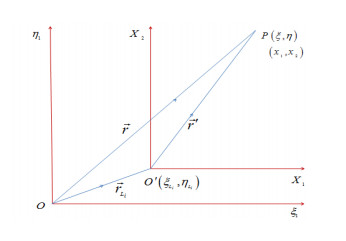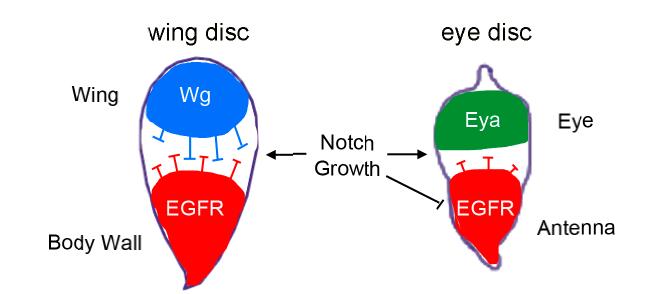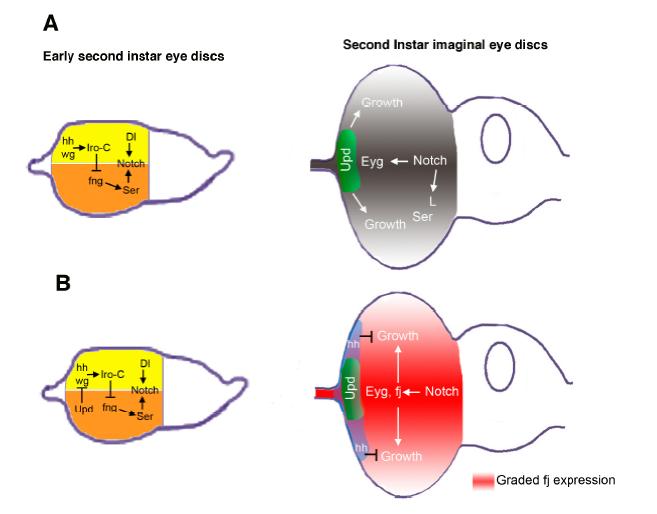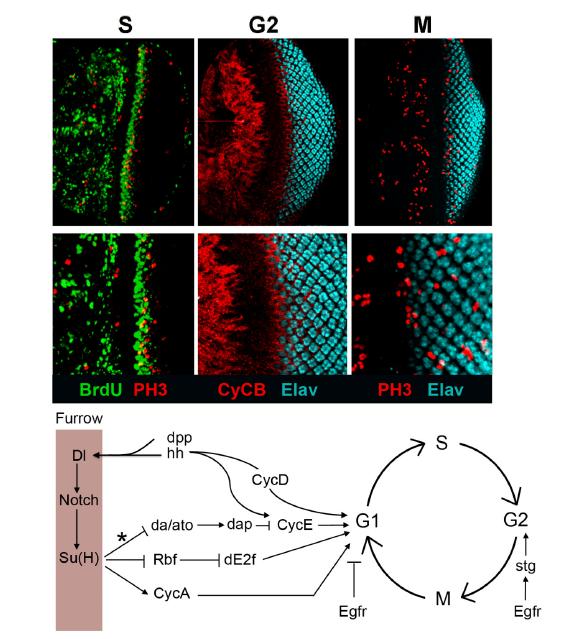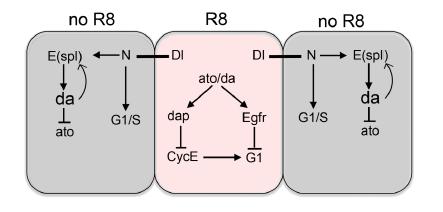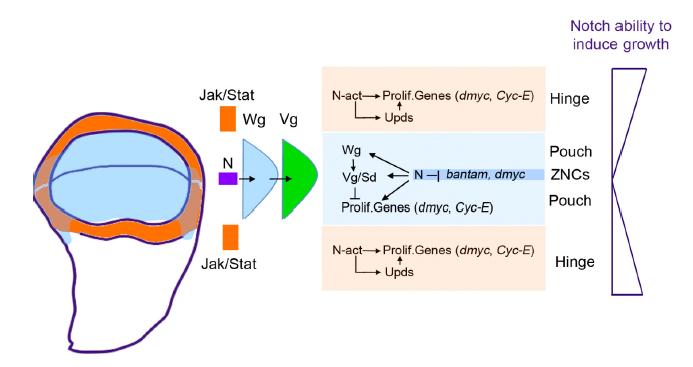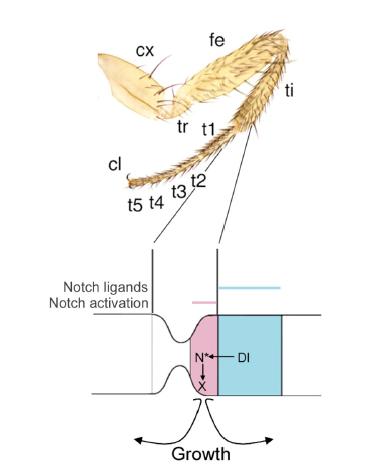|
[1]
|
Hori K, Sen A, Artavanis-Tsakonas S (2013) Notch signaling at a glance. J Cell Sci 126: 2135-2140. doi: 10.1242/jcs.127308

|
|
[2]
|
ArtavanisTsakonas S, Rand MD, Lake RJ (1999) Notch signaling: Cell fate control and signal itegration in development. Science 284: 770-776. doi: 10.1126/science.284.5415.770

|
|
[3]
|
Kopan R, Ilagan MX (2009) The canonical Notch signaling pathway: unfolding the activation mchanism. Cell 137: 216-233. doi: 10.1016/j.cell.2009.03.045

|
|
[4]
|
Andersson ER, Sandberg R, Lendahl U (2011) Notch signaling: simplicity in design, versatility i function. Development 138: 3593-3612. doi: 10.1242/dev.063610

|
|
[5]
|
Louvi A, Artavanis-Tsakonas S (2012) Notch and disease: a growing field. Semin Cell Dev Biol 23: 473-480. doi: 10.1016/j.semcdb.2012.02.005

|
|
[6]
|
Ntziachristos P, Lim JS, Sage J, et al. (2014) From fly wings to targeted cancer therapies: a cntennial for notch signaling. Cancer Cell 25: 318-334. doi: 10.1016/j.ccr.2014.02.018

|
|
[7]
|
Radtke F, Raj K (2003) The role of Notch in tumorigenesis: oncogene or tumour suppressor? Nat Rv Cancer 3: 756-767. doi: 10.1038/nrc1186

|
|
[8]
|
Ranganathan P, Weaver KL, Capobianco AJ (2011) Notch signalling in solid tumours: a little bit o everything but not all the time. Nat Rev Cancer 11: 338-351. doi: 10.1038/nrc3035

|
|
[9]
|
Morgan T (1917) The theory of the gene. Am Nat 51: 513-544.
|
|
[10]
|
Dominguez M (2014) Oncogenic programmes and Notch activity: an 'organized crime'. Semin Cell Dev Biol 28: 78-85. doi: 10.1016/j.semcdb.2014.04.012

|
|
[11]
|
Blaumueller CM, Qi H, Zagouras P, et al. (1997) Intracellular cleavage of Notch leads to a hterodimeric receptor on the plasma membrane. Cell 90: 281-291. doi: 10.1016/S0092-8674(00)80336-0

|
|
[12]
|
Bray SJ (2006) Notch signalling: a simple pathway becomes complex. Nat Rev Mol Cell Biol 7: 678-689. doi: 10.1038/nrm2009

|
|
[13]
|
Fortini ME (2009) Notch signaling: the core pathway and its posttranslational regulation. Dev Cll 16: 633-647. doi: 10.1016/j.devcel.2009.03.010

|
|
[14]
|
Bray S, Bernard F (2010) Notch targets and their regulation. Curr Top Dev Biol 92: 253-275. doi: 10.1016/S0070-2153(10)92008-5

|
|
[15]
|
Kandachar V, Roegiers F (2012) Endocytosis and control of Notch signaling. Curr Opin Cell Bol 24: 534-540. doi: 10.1016/j.ceb.2012.06.006

|
|
[16]
|
Baron M (2012) Endocytic routes to Notch activation. Semin Cell Dev Biol 23: 437-442. doi: 10.1016/j.semcdb.2012.01.008

|
|
[17]
|
Vaccari T, Bilder D (2009) At the crossroads of polarity, proliferation and apoptosis: the use of Dosophila to unravel the multifaceted role of endocytosis in tumor suppression. Mol Oncol 3: 354-365. doi: 10.1016/j.molonc.2009.05.005

|
|
[18]
|
Vaccari T, Lu H, Kanwar R, et al. (2008) Endosomal entry regulates Notch receptor activation in Dosophila melanogaster. J Cell Biol 180: 755-762. doi: 10.1083/jcb.200708127

|
|
[19]
|
Fortini ME, Bilder D (2009) Endocytic regulation of Notch signaling. Curr Opin Genet Dev 19: 323-328. doi: 10.1016/j.gde.2009.04.005

|
|
[20]
|
Lu H, Bilder D (2005) Endocytic control of epithelial polarity and proliferation in Drosophila. Nt Cell Biol 7: 1232-1239. doi: 10.1038/ncb1324

|
|
[21]
|
Morrison HA, Dionne H, Rusten TE, et al. (2008) Regulation of early endosomal entry by the Dosophila tumor suppressors Rabenosyn and Vps45. Mol Biol Cell 19: 4167-4176. doi: 10.1091/mbc.E08-07-0716

|
|
[22]
|
Herz HM, Chen Z, Scherr H, et al. (2006) vps25 mosaics display non-autonomous cell survival ad overgrowth, and autonomous apoptosis. Development 133: 1871-1880. doi: 10.1242/dev.02356

|
|
[23]
|
Herz HM, Bergmann A (2009) Genetic analysis of ESCRT function in Drosophila: a tumour mdel for human Tsg101. Biochem Soc Trans 37: 204-207. doi: 10.1042/BST0370204

|
|
[24]
|
Vaccari T, Rusten TE, Menut L, et al. (2009) Comparative analysis of ESCRT-I, ESCRT-II and ECRT-III function in Drosophila by efficient isolation of ESCRT mutants. J Cell Sci 122: 2413-2423. doi: 10.1242/jcs.046391

|
|
[25]
|
Thompson BJ, Mathieu J, Sung HH, et al. (2005) Tumor suppressor properties of the ESCRT-II cmplex component Vps25 in Drosophila. Dev Cell 9: 711-720. doi: 10.1016/j.devcel.2005.09.020

|
|
[26]
|
Moberg KH, Schelble S, Burdick SK, et al. (2005) Mutations in erupted, the Drosophila ortholog o mammalian tumor susceptibility gene 101, elicit non- cell-autonomous overgrowth. Dev Cell 9: 699-710. doi: 10.1016/j.devcel.2005.09.018

|
|
[27]
|
Vaccari T, Bilder D (2005) The Drosophila tumor suppressor vps25 prevents nonautonomous oerproliferation by regulating notch trafficking. Dev Cell 9:687-698. doi: 10.1016/j.devcel.2005.09.019

|
|
[28]
|
Parsons LM, Portela M, Grzeschik NA, et al. (2014) Lgl regulates Notch signaling via edocytosis, independently of the apical aPKC-Par6-Baz polarity complex. Curr Biol 24:2073-2084. doi: 10.1016/j.cub.2014.07.075

|
|
[29]
|
Haynie JL, Bryant PJ (1986) Development of the eye-antenna imaginal disc and morphogenesis o the adult head in Drosophila melanogaster. J Exp Zool 237: 293-308. doi: 10.1002/jez.1402370302

|
|
[30]
|
Jurgens G, Hartenstein V (1993) The terminal region of the body pattern Cold Spring Harbor, N: Cold Spring Harbor Laboratory Press: 687-746.
|
|
[31]
|
Wolff T, Ready DF (1993) Pattern formation in the Drosophila retina. In: Bate M, Mrtinez-Arias A, editors. The development of Drosophila melanogaster. Cold Spring Harbor, Nw York: Cold Spring Harbor Laboratory Press.
|
|
[32]
|
Garcia-Bellido A (1975) Genetic control of wing disc development in Drosophila. In: Porter R, Rvers J, editors. Cell patterning. Boston: CIBA Symposium. pp. 161-183.
|
|
[33]
|
Baker WK (1978) A clonal analysis reveals early developmental restrictions in the Drosophila had. Dev Biol 62: 447-463. doi: 10.1016/0012-1606(78)90227-0

|
|
[34]
|
Blair SS (1995) Compartments and appendage development in Drosophila. BioEssays 17: 299-309. doi: 10.1002/bies.950170406

|
|
[35]
|
Irvine KD, Rauskolb C (2001) Boundaries in development: formation and function. Annu Rev Cell Dev Biol 17: 189-214. doi: 10.1146/annurev.cellbio.17.1.189

|
|
[36]
|
Kumar JP, Moses K (2001) EGF receptor and Notch signaling act upstream of Eyeless/Pax6 to cntrol eye specification. Cell 104: 687-697. doi: 10.1016/S0092-8674(01)00265-3

|
|
[37]
|
Kenyon KL, Ranade SS, Curtiss J, et al. (2003) Coordinating proliferation and tissue secification to promote regional identity in the Drosophila head. Dev Cell 5: 403-414. doi: 10.1016/S1534-5807(03)00243-0

|
|
[38]
|
Singh A, Tare M, Puli OR, et al. (2011) A glimpse into dorso-ventral patterning of the Dosophila eye. Dev Dyn 241: 69-84.
|
|
[39]
|
Cho KO, Choi KW (1998) Fringe is essential for mirror symmetry and morphogenesis in the Dosophila eye. Nature 396: 272-276. doi: 10.1038/24394

|
|
[40]
|
Dominguez M, de Celis JF (1998) A dorsal/ventral boundary established by Notch controls gowth and polarity in the Drosophila eye. Nature 396: 276-278. doi: 10.1038/24402

|
|
[41]
|
Papayannopoulos V, Tomlinson A, Panin VM, et al. (1998) Dorsal-ventral signaling in the Dosophila eye. Science 281: 2031-2034.
|
|
[42]
|
Cavodeassi F, Diez Del Corral R, Campuzano S, et al. (1999) Compartments and organising bundaries in the Drosophila eye: the role of the homeodomain Iroquois proteins. Development 126: 4933-4942.
|
|
[43]
|
Maurel-Zaffran C, Treisman JE (2000) pannier acts upstream of wingless to direct dorsal eye dsc development in Drosophila. Development 127: 1007-1016.
|
|
[44]
|
Haines N, Irvine KD (2003) Glycosylation regulates Notch signalling. Nat Rev Mol Cell Biol 4: 786-797. doi: 10.1038/nrm1228

|
|
[45]
|
Munro S, Freeman M (2000) The Notch signalling regulator Fringe acts in the Golgi apparatus ad requires the glycosyltransferase signature motif DxD. Curr Biol 10: 813-820. doi: 10.1016/S0960-9822(00)00578-9

|
|
[46]
|
Bruckner K, Perez L, Clausen H, et al. (2000) Glycosyltransferase activity of Fringe modulates Ntch-Delta interactions. Nature 406: 411-415. doi: 10.1038/35019075

|
|
[47]
|
Roignant JY, Treisman JE (2009) Pattern formation in the Drosophila eye disc. Int J Dev Biol 53: 795-804. doi: 10.1387/ijdb.072483jr

|
|
[48]
|
Chao JL, Tsai YC, Chiu SJ, et al. (2004) Localized Notch signal acts through eyg and upd to pomote global growth in Drosophila eye. Development 131: 3839-3847. doi: 10.1242/dev.01258

|
|
[49]
|
Dominguez M, Ferres-Marco D, Gutierrez-Avino FJ, et al. (2004) Growth and specification of te eye are controlled independently by Eyegone and Eyeless in Drosophila melanogaster. Nat Gnet 36: 31-39. doi: 10.1038/ng1281

|
|
[50]
|
Hombria JC, Brown S (2002) The fertile field of Drosophila Jak/STAT signalling. Curr Biol 12: R69-575.
|
|
[51]
|
Tsai YC, Sun YH (2004) Long-range effect of upd, a ligand for Jak/STAT pathway, on cell cycle i Drosophila eye development. Genesis 39: 141-153. doi: 10.1002/gene.20035

|
|
[52]
|
Reynolds-Kenneally J, Mlodzik M (2005) Notch signaling controls proliferation through cll-autonomous and non-autonomous mechanisms in the Drosophila eye. Dev Biol 285: 38-48. doi: 10.1016/j.ydbio.2005.05.038

|
|
[53]
|
Gutierrez-Avino FJ, Ferres-Marco D, Dominguez M (2009) The position and function of the Ntch-mediated eye growth organizer: the roles of JAK/STAT and four-jointed. EMBO Rep 10: 1051-1058. doi: 10.1038/embor.2009.140

|
|
[54]
|
Ishikawa HO, Takeuchi H, Haltiwanger RS, et al. (2008) Four-jointed is a Golgi kinase that posphorylates a subset of cadherin domains. Science 321: 401-404. doi: 10.1126/science.1158159

|
|
[55]
|
Edgar BA (2006) From cell structure to transcription: Hippo forges a new path. Cell 124: 267-273. doi: 10.1016/j.cell.2006.01.005

|
|
[56]
|
Halder G, Johnson RL (2011) Hippo signaling: growth control and beyond. Development 138: 9-22. doi: 10.1242/dev.045500

|
|
[57]
|
Da Ros VG, Gutierrez-Perez I, Ferres-Marco D, et al. (2013) Dampening the signals transduced trough hedgehog via microRNA miR-7 facilitates notch- induced tumourigenesis. PLoS Biol 11: e001554.
|
|
[58]
|
Yao S, Lum L, Beachy P (2006) The ihog cell-surface proteins bind Hedgehog and mediate pthway activation. Cell 125: 343-357. doi: 10.1016/j.cell.2006.02.040

|
|
[59]
|
McLellan JS, Yao S, Zheng X, et al. (2006) Structure of a heparin-dependent complex of Hdgehog and Ihog. Proc Natl Acad Sci U S A 103: 17208-17213. doi: 10.1073/pnas.0606738103

|
|
[60]
|
Camp D, Currie K, Labbe A, et al. (2010) Ihog and Boi are essential for Hedgehog signaling in Dosophila. Neural Dev 5: 28. doi: 10.1186/1749-8104-5-28

|
|
[61]
|
Yan D, Wu Y, Yang Y, et al. (2010) The cell-surface proteins Dally-like and Ihog differentially rgulate Hedgehog signaling strength and range during development. Development 137:2033-2044. doi: 10.1242/dev.045740

|
|
[62]
|
Heberlein U, Singh CM, Luk AY, et al. (1995) Growth and differentiation in the Drosophila eye coordinated by hedgehog. Nature 373: 709-711. doi: 10.1038/373709a0

|
|
[63]
|
Christiansen AE, Ding T, Bergmann A (2012) Ligand-independent activation of the Hedgehog pthway displays non-cell autonomous proliferation during eye development in Drosophila. Mch Dev 129: 98-108. doi: 10.1016/j.mod.2012.05.009

|
|
[64]
|
Jones S, Zhang X, Parsons DW, et al. (2008) Core signaling pathways in human pancreatic cncers revealed by global genomic analyses. Science 321: 1801-1806. doi: 10.1126/science.1164368

|
|
[65]
|
Treisman JE, Heberlein U (1998) Eye development in Drosophila: formation of the eye field and cntrol of differentiation. Curr Top Dev Biol 39: 119-158. doi: 10.1016/S0070-2153(08)60454-8

|
|
[66]
|
Wolff T, Ready DF (1991) The beginning of pattern formation in the Drosophila compound eye: te morphogenetic furrow and the second mitotic wave. Development 113: 841-850.
|
|
[67]
|
Heberlein U, Moses K (1995) Mechanisms of Drosophila retinal morphogenesis: The virtues of bing progressive. Cell 81: 987-990. doi: 10.1016/S0092-8674(05)80003-0

|
|
[68]
|
Horsfield J, Penton A, Secombe J, et al. (1998) decapentaplegic is required for arrest in G1 phase dring Drosophila eye development. Development 125: 5069-5078.
|
|
[69]
|
Penton A, Selleck SB, Hoffmann FM (1997) Regulation of cell cycle synchronization by dcapentaplegic during Drosophila eye development. Science 275: 203-206. doi: 10.1126/science.275.5297.203

|
|
[70]
|
Thomas BJ, Gunning DA, Cho J, et al. (1994) Cell cycle progression in the developing Dosophila eye: Roughex encodes a novel protein required for the establishment of G1. Cell 77:1003-1014. doi: 10.1016/0092-8674(94)90440-5

|
|
[71]
|
De Nooij JC, Hariharan IK (1995) Uncoupling cell fate determination from patterned cell dvision in the Drosophila eye. Science 270: 983-985. doi: 10.1126/science.270.5238.983

|
|
[72]
|
Baonza A, Freeman M (2005) Control of cell proliferation in the Drosophila eye by Notch sgnaling. Dev Cell 8: 529-539. doi: 10.1016/j.devcel.2005.01.019

|
|
[73]
|
Firth LC, Baker NE (2005) Extracellular signals responsible for spatially regulated proliferation i the differentiating Drosophila eye. Dev Cell 8: 541-551. doi: 10.1016/j.devcel.2005.01.017

|
|
[74]
|
Sukhanova MJ, Du W (2008) Control of cell cycle entry and exiting from the second mitotic wve in the Drosophila developing eye. BMC Dev Biol 8: 7. doi: 10.1186/1471-213X-8-7

|
|
[75]
|
Knoblich JA, Sauer K, Jones L, et al. (1994) Cyclin E controls S phase progression and its down rgulation during Drosophila embryogenesis is required for the arrest of cell proliferation. Cell77: 107-120. doi: 10.1016/0092-8674(94)90239-9

|
|
[76]
|
Lane ME, Sauer K, Wallace K, et al. (1996) Dacapo, a cyclin-dependent kinase inhibitor, stops cll proliferation during Drosophila development. Cell 87: 1225-1235. doi: 10.1016/S0092-8674(00)81818-8

|
|
[77]
|
Reis T, Edgar BA (2004) Negative regulation of dE2F1 by cyclin-dependent kinases controls cell ccle timing. Cell 117: 253-264. doi: 10.1016/S0092-8674(04)00247-8

|
|
[78]
|
Ma C, Moses K (1995) wingless and patched are negative regulators of the morphogenetic frrow and can affect tissue polarity in the developing Drosophila compound eye. Development121: 2279-2289.
|
|
[79]
|
Heberlein U, Hariharan IK, Rubin GM (1993) Star is required for neuronal differentiation in the Dosophila retina and displays dosage-sensitive interactions with Ras1. Devl Biol 160: 51-63. doi: 10.1006/dbio.1993.1285

|
|
[80]
|
Domínguez M, Hafen E (1997) Hedgehog directly controls initiation and propagation of retinal dfferentiation in the Drosophila eye. Genes Dev 11: 3254-3264. doi: 10.1101/gad.11.23.3254

|
|
[81]
|
Greenwood S, Struhl G (1999) Progression of the morphogenetic furrow in the Drosophila eye: te roles of Hedgehog, Decapentaplegic and the Raf pathway. Development 126: 5795-5808.
|
|
[82]
|
Masucci JD, Miltenberger RJ, Hoffmann FM (1990) Pattern-specific expression of the Drosophila decapentaplegic gene in inaginal disks is regulated by 3' cis- regulatory elements. Gnes Dev 4: 2011-2023. doi: 10.1101/gad.4.11.2011

|
|
[83]
|
Baker NE, Yu SY (2001) The EGF receptor defines domains of cell cycle progression and srvival to regulate cell number in the developing Drosophila eye. Cell 104: 699-708. doi: 10.1016/S0092-8674(01)00266-5

|
|
[84]
|
Duman-Scheel M, Weng L, Xin S, et al. (2002) Hedgehog regulates cell growth and proliferation b inducing Cyclin D and Cyclin E. Nature 417: 299-304. doi: 10.1038/417299a

|
|
[85]
|
Dominguez M, Brunner M, Hafen E, et al. (1996) Sending and receiving the hedgehog signal: Cntrol by the Drosophila Gli protein Cubitus interruptus. Science 272: 1621-1625. doi: 10.1126/science.272.5268.1621

|
|
[86]
|
Domínguez M (1999) Dual role for Hedgehog in the regulation of the proneural gene atonal dring ommatidia development. Development 126: 2345-2353.
|
|
[87]
|
Jarman AP, Grell EH, Ackerman L, et al. (1994) atonal is the proneural gene for Drosophila potoreceptors. Nature 369: 398-400. doi: 10.1038/369398a0

|
|
[88]
|
Bossuyt W, De Geest N, Aerts S, et al. (2009) The atonal proneural transcription factor links dfferentiation and tumor formation in Drosophila. PLoS Biol 7: e40. doi: 10.1371/journal.pbio.1000040

|
|
[89]
|
Lim J, Jafar-Nejad H, Hsu YC, et al. (2008) Novel function of the class I bHLH protein Dughterless in the negative regulation of proneural gene expression in the Drosophila eye. EBO Rep 9: 1128-1133.
|
|
[90]
|
Sukhanova MJ, Deb DK, Gordon GM, et al. (2007) Proneural basic helix-loop- helix proteins ad epidermal growth factor receptor signaling coordinately regulate cell type specification and ck inhibitor expression during development. Mol Cell Biol 27: 2987-2996. doi: 10.1128/MCB.01685-06

|
|
[91]
|
Singh A, Choi KW (2003) Initial state of the Drosophila eye before dorsoventral specification is euivalent to ventral. Development 130: 6351-6360. doi: 10.1242/dev.00864

|
|
[92]
|
Chern JJ, Choi KW (2002) Lobe mediates Notch signaling to control domain- specific growth in te Drosophila eye disc. Development 129: 4005-4013.
|
|
[93]
|
Sun X, Artavanis-Tsakonas S (1996) The intracellular deletions of Delta and Serrate define dminant negative forms of the Drosophila Notch ligands. Development 122: 2465-2474.
|
|
[94]
|
Furriols M, Bray S (2001) A model Notch response element detects Suppressor of Hirless-dependent molecular switch. Curr Biol 11: 60-64. doi: 10.1016/S0960-9822(00)00044-0

|
|
[95]
|
de Celis JF, Tyler DM, de Celis J, et al. (1998) Notch signalling mediates segmentation of the Dosophila leg. Development 125: 4617-4626.
|
|
[96]
|
Rafel N, Milan M (2008) Notch signalling coordinates tissue growth and wing fate specification i Drosophila. Development 135: 3995-4001. doi: 10.1242/dev.027789

|
|
[97]
|
Diaz-Benjumea F, Cohen SM (1993) Interactions between dorsal and ventral cells in the iaginal disc directs wing development in Drosophila. Cell 75: 741-752. doi: 10.1016/0092-8674(93)90494-B

|
|
[98]
|
Tabata T, Schwartz C, Gustavson E, et al. (1995) Creating a Drosophila wing de novo, the role o engrailed and the compartment hypotesis. Development 121: 3359-3369.
|
|
[99]
|
Zecca M, Basler K, Struhl G (1995) Sequential organizing activities of engrailed, hedgehog and dcapentaplegic in the Drosophila wing. Development 121: 2265-2278.
|
|
[100]
|
Lawrence PA, Morata G (1976) Compartments in the wing of Drosophila: a study of the egrailed gene. Dev Biol 50: 321-337. doi: 10.1016/0012-1606(76)90155-X

|
|
[101]
|
Blair SS, Brower DL, Thomas JB, et al. (1994) The role of apterous in the control of drsoventral compartmentalization and PS integrin gene expression in the developing wing of Dosophila. Development 120: 1805-1815.
|
|
[102]
|
Diaz-Benjumea FJ, Cohen SM (1995) Serrate signals through Notch to establish a Wingless-dependent organizer at the dorsal/ventral compartment boundary of the Drosophila wng. Development 121: 4215-4225.
|
|
[103]
|
Milan M, Cohen SM (2000) Subdividing cell populations in the developing limbs of Drosophila: d wing veins and leg segments define units of growth control? Dev Biol 217: 1-9. doi: 10.1006/dbio.1999.9493

|
|
[104]
|
de Celis JF, García-Bellido A, Bray SJ (1996a) Activation and function of Notch at the drso-ventral boundary of the wing imaginal disc. Development 122: 359-369.
|
|
[105]
|
Doherty D, Feger G, Younger-Shepherd S, et al. (1996) Delta is a ventral to dorsal signal cmplementary to Serrate, another Notch ligand, in Drosophila wing formation. Genes Dev 10:421-434. doi: 10.1101/gad.10.4.421

|
|
[106]
|
Fleming RJ, Gu Y, Hukriede NA (1997) Serrate-mediated activaction of Notch is specifically bocked by the product of the gene fringe in the dorsal compartment of the Drosophila wing iaginal disc. Development 124: 2973-2981.
|
|
[107]
|
Panin VM, Papayannopoulos V, Wilson R, et al. (1997) fringe modulates Notch-ligand iteractions. Nature 387: 908-912. doi: 10.1038/43191

|
|
[108]
|
Kim J, Irvine KD, Carroll SB (1995) Cell recognition, signal induction, and symmetrical gene ativation at the dorsal-ventral boundary of the developing Drosophila wing. Cell 82: 795-802. doi: 10.1016/0092-8674(95)90476-X

|
|
[109]
|
Couso JP, Knust E, Martínez Arias A (1995) Serrate and wingless cooperate to induce vestigial gne expression and wing formation in Drosophila. Curr Biol 5: 1437-1448. doi: 10.1016/S0960-9822(95)00281-8

|
|
[110]
|
Irvine KD, Wieschaus E (1994) fringe, a boundary-specific signalling molecule, mediates iteractions between dorsal and ventral cells during Drosophila wing development. Cell 79:595-606. doi: 10.1016/0092-8674(94)90545-2

|
|
[111]
|
Kim J, Sebring A, Esch JJ, et al. (1996) Integration of positional signals and regulation of wing frmation and identity by Drosophila vestigial gene. Nature 382: 133-138. doi: 10.1038/382133a0

|
|
[112]
|
Baena-Lopez LA, Garcia-Bellido A (2006) Control of growth and positional information by the gaded vestigial expression pattern in the wing of Drosophila melanogaster. Proc Natl Acad Sci US A 103: 13734-13739. doi: 10.1073/pnas.0606092103

|
|
[113]
|
Baena-Lopez LA, Nojima H, Vincent JP (2012) Integration of morphogen signalling within the gowth regulatory network. Curr Opin Cell Biol 24: 166-172. doi: 10.1016/j.ceb.2011.12.010

|
|
[114]
|
Neumann CJ, Cohen SM (1996) A hierarchy of cross-regulation involving Notch, wingless, vstigial and cut organizes the dorsal/ventral axis of the Drosophila wing. Development 122:3477-3485.
|
|
[115]
|
Zecca M, Struhl G (2007) Recruitment of cells into the Drosophila wing primordium by a fed-forward circuit of vestigial autoregulation. Development 134: 3001-3010. doi: 10.1242/dev.006411

|
|
[116]
|
Klein T, Martinez-Arias A (1999) The Vestigial gene product provides a molecular context for te interpretation of signals during the development of the wing in Drosophila. Development 126:913-925.
|
|
[117]
|
Klein T, Martinez Arias A (1998) Different spatial and temporal interactions between Notch, wngless, and vestigial specify proximal and distal pattern elements of the wing in Drosophila. Dv Biol 194: 196-212.
|
|
[118]
|
Williams JA, Bell JB, Carroll SB (1991) Control of Drosophila wing and haltere development by te nuclear vestigial gene product. Genes Dev 5: 2481-2495. doi: 10.1101/gad.5.12b.2481

|
|
[119]
|
Baonza A, Garcia-Bellido A (2000) Notch signaling directly controls cell proliferation in the Dosophila wing disc. Proc Natl Acad Sci U S A 97: 2609-2614. doi: 10.1073/pnas.040576497

|
|
[120]
|
Go JM, Eastman DS, Artavanis-Tsakonas S (1998) Cell proliferation control by Notch signaling in Drosophila development. Development 125: 2031-2040.
|
|
[121]
|
Giraldez AJ, Cohen SM (2003) Wingless and Notch signaling provide cell survival cues and cntrol cell proliferation during wing development. Development 130: 6533-6543. doi: 10.1242/dev.00904

|
|
[122]
|
de Celis JF, Garcia-Bellido A (1994) Roles of the Notch gene in Drosophila wing morphogenesis. Mch Dev 46: 109-122. doi: 10.1016/0925-4773(94)90080-9

|
|
[123]
|
Baonza A, Roch F, Martin-Blanco E (2000) DER signaling restricts the boundaries of the wing feld during Drosophila development. Proc Natl Acad Sci U S A 97: 7331-7335. doi: 10.1073/pnas.97.13.7331

|
|
[124]
|
Zecca M, Struhl G (2002) Subdivision of the Drosophila wing imaginal disc by EGFR-mediated sgnaling. Development 129: 1357-1368.
|
|
[125]
|
Wang SH, Simcox A, Campbell G (2000) Dual role for Drosophila epidermal growth factor rceptor signaling in early wing disc development. Genes Dev 14: 2271-2276. doi: 10.1101/gad.827000

|
|
[126]
|
Simcox AA, Grumbling G, Schnepp B, et al. (1996) Molecular, phenotypic, and expression aalysis of vein, a gene required for growth of the Drosophila wing disc. Devl Biol 177:475-489. doi: 10.1006/dbio.1996.0179

|
|
[127]
|
Paul L, Wang SH, Manivannan SN, et al. (2013) Dpp-induced Egfr signaling triggers pstembryonic wing development in Drosophila. Proc Natl Acad Sci U S A 110: 5058-5063. doi: 10.1073/pnas.1217538110

|
|
[128]
|
O'Brochta D, Bryant PJ (1985) A zone of non-proliferating cells at a lineage restriction boundary i Drosophila. Nature 313: 138-141. doi: 10.1038/313138a0

|
|
[129]
|
Johnston LA, Edgar BA (1998) Wingless and Notch regulate cell-cycle arrest in the developing Dosophila wing. Nature 394: 82-84. doi: 10.1038/27925

|
|
[130]
|
Buceta J, Herranz H, Canela-Xandri O, et al. (2007) Robustness and stability of the gene rgulatory network involved in DV boundary formation in the Drosophila wing. PLoS One 2: e02.
|
|
[131]
|
Herranz H, Perez L, Martin FA, et al. (2008) A Wingless and Notch double- repression mchanism regulates G1-S transition in the Drosophila wing. Embo J 27: 1633-1645. doi: 10.1038/emboj.2008.84

|
|
[132]
|
Andrade-Zapata I, Baonza A (2014) The bHLH factors extramacrochaetae and daughterless cntrol cell cycle in Drosophila imaginal discs through the transcriptional regulation of the Cc25 phosphatase string. PLoS Genet 10: e1004233. doi: 10.1371/journal.pgen.1004233

|
|
[133]
|
de Celis JF, de Celis J, Ligoxiars P, et al. (1996) Functional relationships between Notch and bLH genes of the E(spl) complex: the E(spl) genes mediate only a subset of Notch activies dring imaginal development. Development 122: 2719-2728.
|
|
[134]
|
Massari ME, Murre C (2000) Helix-loop-helix proteins: regulators of transcription in eucaryotic oganisms. Mol Cell Biol 20: 429-440. doi: 10.1128/MCB.20.2.429-440.2000

|
|
[135]
|
San Juan BP, Andrade-Zapata I, Baonza A (2012) The bHLH factors Dpn and members of the Espl) complex mediate the function of Notch signaling regulating cell proliferation during wing dsc development. Biol Open 1: 667-676. doi: 10.1242/bio.20121172

|
|
[136]
|
Djiane A, Krejci A, Bernard F, et al. (2013) Dissecting the mechanisms of Notch induced hperplasia. Embo J 32: 60-71.
|
|
[137]
|
Rulifson EJ, Blair SS (1995) Notch regulates wingless expression and is not required for the rception of paracrine wingless signals during wing margin development in Drosophila. Dvelopment 121: 2813-2824.
|
|
[138]
|
Klein T, Martinez-Arias A (1997) An intrisic dominant negative activity of Serrate that is mdulated during wing development in Drosophila. Dev Biol 189: 123-134. doi: 10.1006/dbio.1997.8564

|
|
[139]
|
Alexandre C, Baena-Lopez A, Vincent JP (2014) Patterning and growth control by membrane-tethered Wingless. Nature 505: 180-185.
|
|
[140]
|
Johnston LA, Sanders AL (2003) Wingless promotes cell survival but constrains growth during Dosophila wing development. Nat Cell Biol 5: 827-833. doi: 10.1038/ncb1041

|
|
[141]
|
Halder G, Polaczyk P, Kraus ME, et al. (1998) The Vestigial and Scalloped proteins act together t directly regulate wing-specific gene expression in Drosophila. Genes Dev 12: 3900-3909. doi: 10.1101/gad.12.24.3900

|
|
[142]
|
Simmonds AJ, Liu X, Soanes KH, et al. (1998) Molecular interactions between Vestigial and Salloped promote wing formation in Drosophila. Genes Dev 12: 3815-3820. doi: 10.1101/gad.12.24.3815

|
|
[143]
|
Zhao B, Tumaneng K, Guan KL (2011) The Hippo pathway in organ size control, tissue rgeneration and stem cell self-renewal. Nat Cell Biol 13: 877-883. doi: 10.1038/ncb2303

|
|
[144]
|
Djiane A, Zaessinger S, Babaoglan AB, et al. (2014) Notch inhibits Yorkie activity in Drosophila wng discs. PLoS One 9: e106211. doi: 10.1371/journal.pone.0106211

|
|
[145]
|
Graves HK, Woodfield SE, Yang CC, et al. (2012) Notch signaling activates Yorkie non-cell atonomously in Drosophila. PLoS One 7: e37615. doi: 10.1371/journal.pone.0037615

|
|
[146]
|
Bach EA, Ekas LA, Ayala-Camargo A, et al. (2007) GFP reporters detect the activation of the Dosophila JAK/STAT pathway in vivo. Gene Expr Patterns 7: 323-331. doi: 10.1016/j.modgep.2006.08.003

|
|
[147]
|
Rauskolb C, Irvine KD (1999) Notch-mediated segmentation and growth control of the Dosophila leg. Dev Biol 210: 339-350. doi: 10.1006/dbio.1999.9273

|
|
[148]
|
Bishop SA, Klein T, Arias AM, et al. (1999) Composite signalling from Serrate and Delta etablishes leg segments in Drosophila through Notch. Development 126: 2993-3003.
|
|
[149]
|
Estella C, Voutev R, Mann RS (2012) A dynamic network of morphogens and transcription fctors patterns the fly leg. Curr Top Dev Biol 98: 173-198. doi: 10.1016/B978-0-12-386499-4.00007-0

|
|
[150]
|
Kerber B, Monge I, Mueller M, et al. (2001) The AP-2 transcription factor is required for joint frmation and cell survival in Drosophila leg development. Development 128: 1231-1238.
|
|
[151]
|
Saj A, Arziman Z, Stempfle D, et al. (2010) A combined ex vivo and in vivo RNAi screen for ntch regulators in Drosophila reveals an extensive notch interaction network. Dev Cell 18:862-876. doi: 10.1016/j.devcel.2010.03.013

|
|
[152]
|
Ferres-Marco D, Gutierrez-Garcia I, Vallejo DM, et al. (2006) Epigenetic silencers and Notch cllaborate to promote malignant tumours by Rb silencing. Nature 439: 430-436. doi: 10.1038/nature04376

|
|
[153]
|
Brumby AM, Richardson HE (2003) scribble mutants cooperate with oncogenic Ras or Notch to cuse neoplastic overgrowth in Drosophila. Embo J 22: 5769-5779. doi: 10.1093/emboj/cdg548

|
|
[154]
|
Brumby AM, Richardson HE (2005) Using Drosophila melanogaster to map human cancer pthways. Nat Rev Cancer 5: 626-639. doi: 10.1038/nrc1671

|
|
[155]
|
Pagliarini RA, Xu T (2003) A genetic screen in Drosophila for metastatic behavior. Science 302:1227-1231. doi: 10.1126/science.1088474

|
|
[156]
|
Miles WO, Dyson NJ, Walker JA (2011) Modeling tumor invasion and etastasis in Drosophila. Ds Model Mech 4: 753-761. doi: 10.1242/dmm.006908

|
|
[157]
|
Elsum I, Yates L, Humbert PO, et al. (2012) The Scribble-Dlg-Lgl polarity module in dvelopment and cancer: from flies to man. Essays Biochem 53: 141-168. doi: 10.1042/bse0530141

|
|
[158]
|
Leong GR, Goulding KR, Amin N, et al. (2009) Scribble mutants promote aPKC and JK-dependent epithelial neoplasia independently of Crumbs. BMC Biol 7: 62. doi: 10.1186/1741-7007-7-62

|
|
[159]
|
Zeitler J, Hsu CP, Dionne H, et al. (2004) Domains controlling cell polarity and proliferation in te Drosophila tumor suppressor Scribble. J Cell Biol 167: 1137-1146. doi: 10.1083/jcb.200407158

|
|
[160]
|
Parsons LM, Grzeschik NA, Allott ML, et al. (2010) Lgl/aPKC and Crb regulate the Slvador/Warts/Hippo pathway. Fly (Austin) 4: 288-293. doi: 10.4161/fly.4.4.13116

|
|
[161]
|
Robinson BS, Huang J, Hong Y, et al. (2010) Crumbs regulates Salvador/Warts/Hippo signaling i Drosophila via the FERM-domain protein Expanded. Curr Biol 20: 582-590. doi: 10.1016/j.cub.2010.03.019

|
|
[162]
|
Grzeschik NA, Amin N, Secombe J, et al. (2007) Abnormalities in cell proliferation and aico-basal cell polarity are separable in Drosophila lgl mutant clones in the developing eye. Dev Bol 311: 106-123. doi: 10.1016/j.ydbio.2007.08.025

|
|
[163]
|
Cohen B, Shimizu M, Izrailit J, et al. (2010) Cyclin D1 is a direct target of JAG1-mediated Ntch signaling in breast cancer. Breast Cancer Res Treat 123: 113-124. doi: 10.1007/s10549-009-0621-9

|
|
[164]
|
Ling H, Sylvestre JR, Jolicoeur P (2010) Notch1-induced mammary tumor development is cyclin D-dependent and correlates with expansion of pre- malignant multipotent duct-limited pogenitors. Oncogene 29: 4543-4554. doi: 10.1038/onc.2010.186

|
|
[165]
|
Sharma VM, Calvo JA, Draheim KM, et al. (2006) Notch1 contributes to mouse T-cell leukemia b directly inducing the expression of c-myc. Mol Cell Biol 26: 8022-8031. doi: 10.1128/MCB.01091-06

|
|
[166]
|
Weng AP, Millholland JM, Yashiro-Ohtani Y, et al. (2006) c-Myc is an important direct target of Ntch1 in T-cell acute lymphoblastic leukemia/lymphoma. Genes Dev 20: 2096-2109. doi: 10.1101/gad.1450406

|
|
[167]
|
Klinakis A, Szabolcs M, Politi K, et al. (2006) Myc is a Notch1 transcriptional target and a rquisite for Notch1-induced mammary tumorigenesis in mice. Proc Natl Acad Sci U S A 103:9262-9267. doi: 10.1073/pnas.0603371103

|
|
[168]
|
Dohda T, Maljukova A, Liu L, et al. (2007) Notch signaling induces SKP2 expression and pomotes reduction of p27Kip1 in T-cell acute lymphoblastic leukemia cell lines. Exp Cell Res 313: 3141-3152. doi: 10.1016/j.yexcr.2007.04.027

|
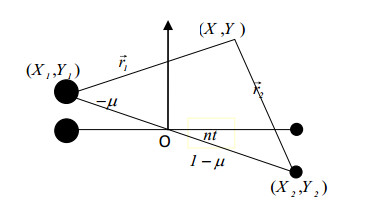









 DownLoad:
DownLoad:
